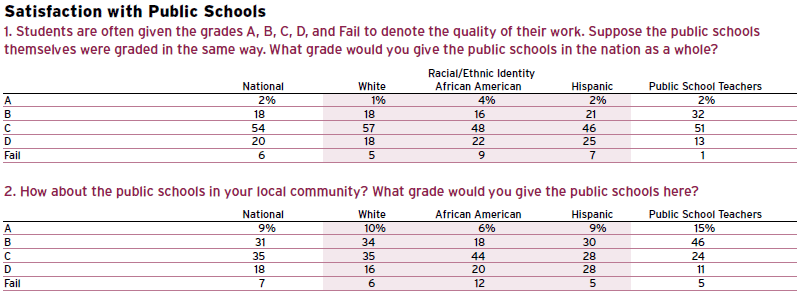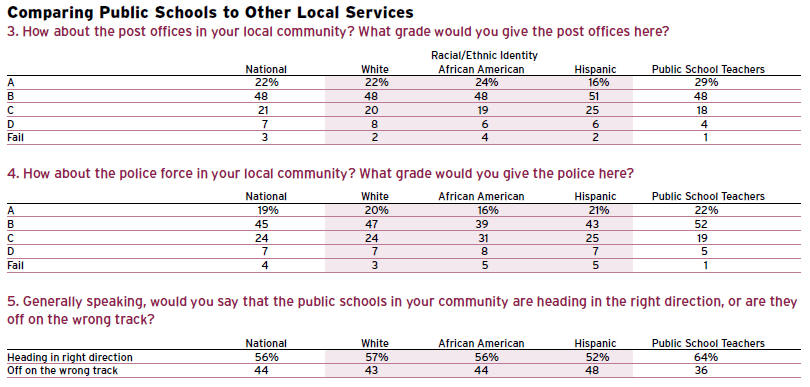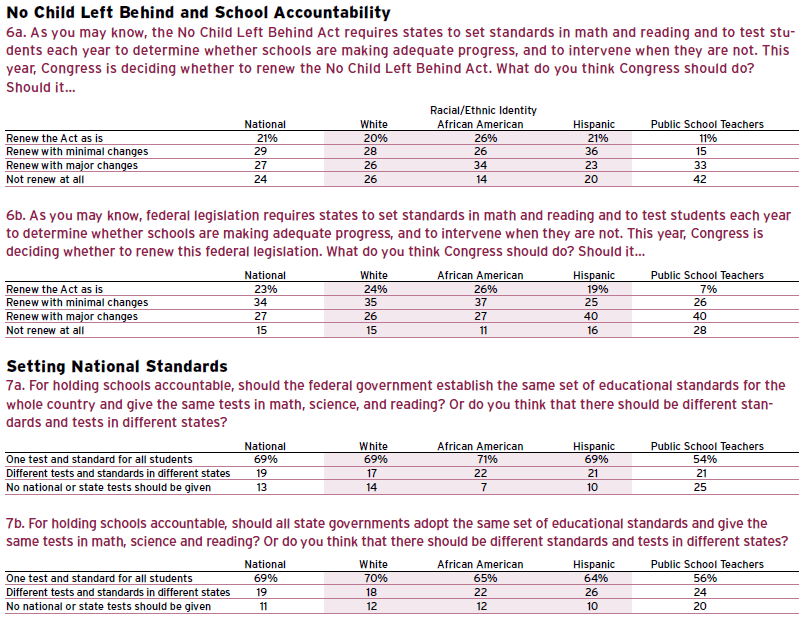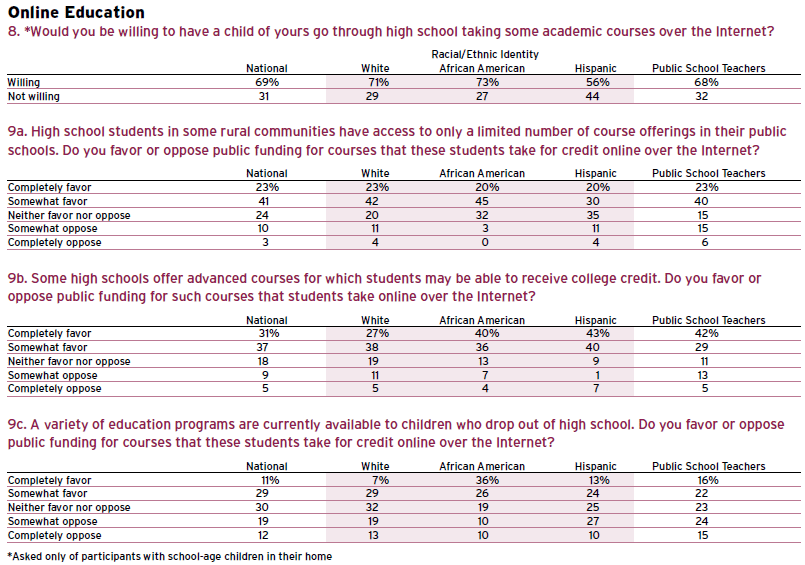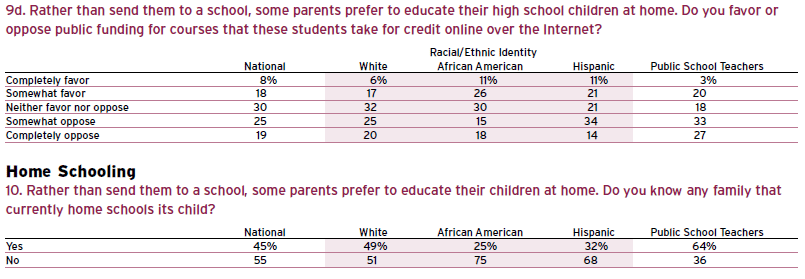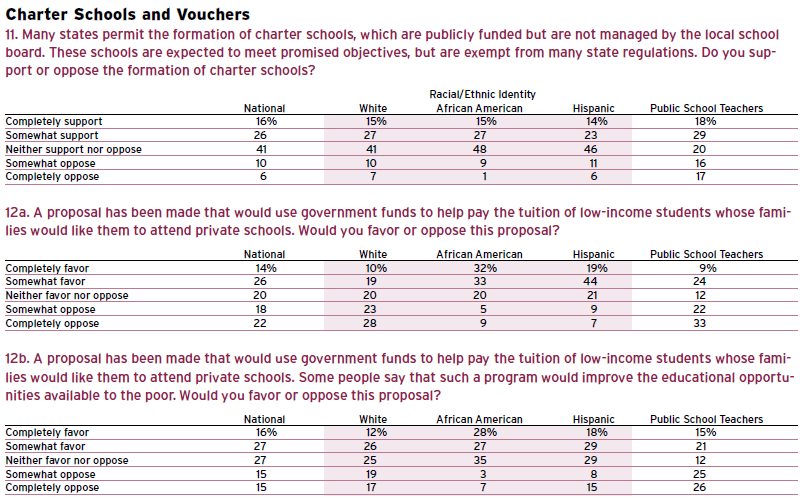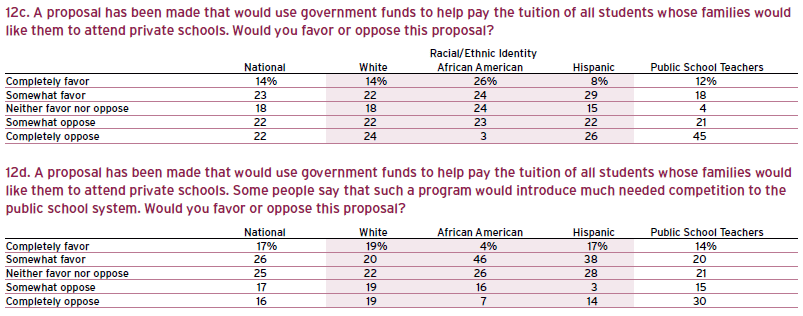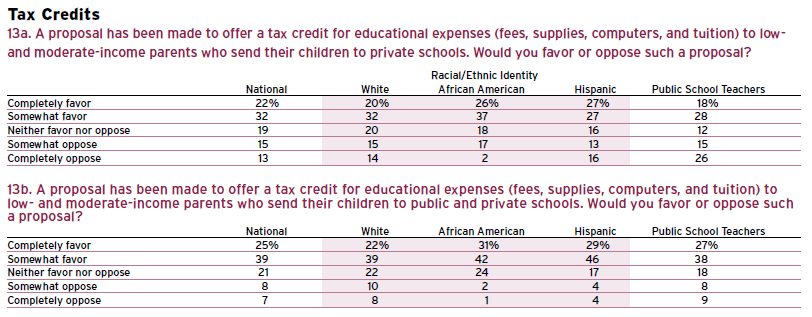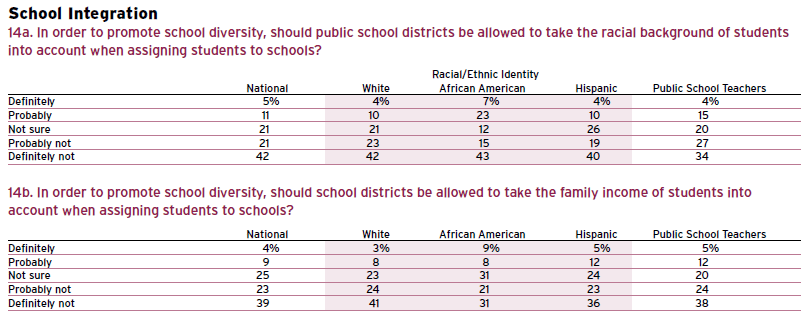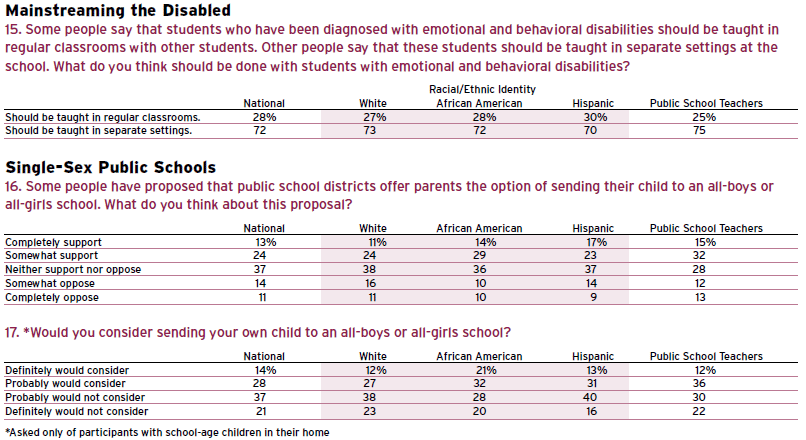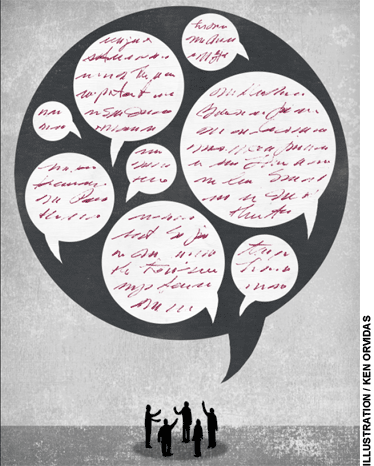 Americans clearly have had their fill of a sluggish economy and an unpopular war. Their frustration now may also extend to public education. In this, the second annual national survey of U.S. adults conducted under the auspices of Education Next and the Program on Education Policy and Governance (PEPG) at Harvard University, we observe a public that takes an increasingly critical view both of public schools as they exist today and, perhaps ironically, of many prominent reforms designed to improve them.
Americans clearly have had their fill of a sluggish economy and an unpopular war. Their frustration now may also extend to public education. In this, the second annual national survey of U.S. adults conducted under the auspices of Education Next and the Program on Education Policy and Governance (PEPG) at Harvard University, we observe a public that takes an increasingly critical view both of public schools as they exist today and, perhaps ironically, of many prominent reforms designed to improve them.
Local public schools receive lower marks than they did a year ago. More significantly, perhaps, survey respondents claim that their local post offices and police forces outperform their local schools. Meanwhile, support for the most far-reaching federal effort to reform public schools—the No Child Left Behind Act—has slipped. A considerable portion of the public remains undecided about charter schools. And the poll found no enthusiasm for the use of income rather than race as a basis for assigning students to schools.
This does not mean that Americans are unwilling to explore alternate ways of educating young people. A large majority of Americans would let their child take some high school courses for credit over the Internet. An equally large majority favor the education of students with emotional and behavioral disabilities in separate classrooms rather than “mainstreaming” them, as is common practice. A plurality support giving parents the option of sending their child to an all-boys or all-girls public school. And a rising number of Americans know someone who is home schooling a child.
These and other findings appear in the 2008 Education Next –PEPG survey, which once again examines the views of U.S. adults taken as a whole, as well as those of white, African American, and Hispanic subgroups. In addition to the opinions of respondents from different ethnic backgrounds, we take a special look at those of public school teachers. Responses for the public as a whole and for the subgroups are reported in the tables that follow. We have also posted responses to additional questions not discussed in this essay.
Before turning to the main findings, we note an innovation in this year’s survey: the increased use of survey experiments, which are rarely employed in national education surveys. By randomly asking respondents slightly different questions about the same issue, we were able to investigate whether adjustments to policies such as national standards, affirmative action, school vouchers, and tax credits could attract broader support. In most cases, the types of policy distinctions that loom large among policy experts have little impact on public opinion. But in one or two instances, most notably the purposes for which online courses might be used, policy changes elicited quite different levels of public support.
Satisfaction with Public Schools
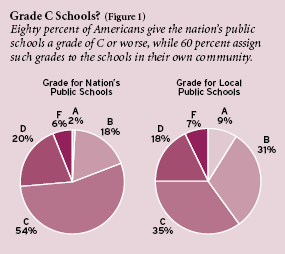 When asked to grade the nation’s public schools as a whole, Americans offer decidedly mixed assessments. Most notably, more of them give the schools a D or an F than assign an A or a B. Only 20 percent of survey respondents give the schools in the nation as a whole one of the two top grades, over 50 percent give them a C, and no less than 25 percent grade them with a D or an F. African Americans and Hispanics are even more likely than whites to give the nation’s schools low marks. But teachers offer the schools systematically higher grades than the rest of the public. Thirty-four percent give the schools an A or a B, while only 14 percent give them one of the two lowest grades (Q.1).
When asked to grade the nation’s public schools as a whole, Americans offer decidedly mixed assessments. Most notably, more of them give the schools a D or an F than assign an A or a B. Only 20 percent of survey respondents give the schools in the nation as a whole one of the two top grades, over 50 percent give them a C, and no less than 25 percent grade them with a D or an F. African Americans and Hispanics are even more likely than whites to give the nation’s schools low marks. But teachers offer the schools systematically higher grades than the rest of the public. Thirty-four percent give the schools an A or a B, while only 14 percent give them one of the two lowest grades (Q.1).
On the whole, survey respondents offered slightly lower evaluations of the nation’s schools in 2008 than they did in 2007, and some groups posted sharp declines. Twenty-seven percent of African Americans gave the public schools an A or a B in 2007, but in 2008, that figure fell to 20 percent. Meanwhile, the share of African Americans giving schools a D or an F rose from 20 percent to 31 percent. The share of Hispanics awarding schools a similarly poor grade doubled during the period, from 16 to 32 percent. For results from the 2007 poll, see “What Americans Think about Their Schools,” features , Fall 2007.
As other surveys have shown, the public’s evaluations become somewhat more favorable when the subject turns to the public schools in their own communities (see Figure 1).Forty percent of the public give the public schools in their community an A or a B, while a quarter give them a D or an F. African Americans assign lower marks: only a quarter give their local public schools an A or a B, while a third give them a D or an F. Public school teachers, meanwhile, offer the highest assessments of their local public schools: fully 61 percent give local schools an A or a B, while only 16 percent assign them a D or an F (Q.2).
Comparing Public Schools to Other Local Services
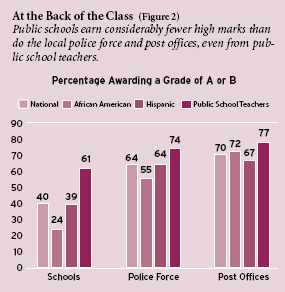
Ratings of local public schools stand in stark contrast to assessments of post offices and police forces. Over 60 percent of respondents give the post offices and police force in their local community an A or a B, and only 10 percent give them a D or an F. Even teachers assign the local post office and police force higher marks than local public schools (see Figure 2). In fact, teachers are twice as likely to give the local post office an A and 50 percent more likely to give the police force an A than they are to similarly grade the local public schools. Teachers are more than twice as likely to assign their public schools a D or an F as they are to give this rating to the post offices or police in their communities (Q. 3, 4).
A slight majority of those surveyed, nonetheless, think that the public schools in their community are improving. Fifty-six percent of the public say that the local public schools are heading in the right direction, compared to 44 percent who believe they are on the wrong track. In this respect, Americans’ views of the nation’s education system appear to be considerably more optimistic than their views about the affairs of the nation more generally. When Gallup, NBC and the Wall Street Journal , and the Associated Press used the same language to ask Americans about the direction of the nation as a whole while our survey was in the field, less than one-quarter reported that it is on the right track (Q. 5).
No Child Left Behind and School Accountability
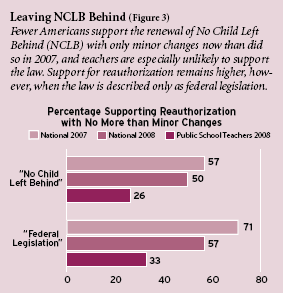 With the presidential election in high gear, and Democrats fixing their attention on President Bush’s signature education achievement, public support for the No Child Left Behind Act appears to be waning. Whereas 57 percent of the public in 2007 suggested that Congress renew the act as is or with minimal changes, only 50 percent of the public do so in 2008. Comparable declines in support are registered among whites, African Americans, and Hispanics.
With the presidential election in high gear, and Democrats fixing their attention on President Bush’s signature education achievement, public support for the No Child Left Behind Act appears to be waning. Whereas 57 percent of the public in 2007 suggested that Congress renew the act as is or with minimal changes, only 50 percent of the public do so in 2008. Comparable declines in support are registered among whites, African Americans, and Hispanics.
Public school teachers are especially critical of the No Child Left Behind Act. Only 26 percent of teachers suggest that Congress renew the act as is or with minimal changes. By contrast, 33 percent suggest that Congress completely overhaul the act, and another 42 percent recommend that Congress not renew the act at all.
Last year, we presented evidence from an experiment suggesting that the very words “No Child Left Behind” were politically charged. This year we repeated the experiment, which randomly assigned individuals to one of two conditions: the first referred to the act by name, and the second simply identified “federal legislation.” The main findings reappear, though the differences are not as large (see Figure 3). Whereas in 2007 the mere reference to “No Child Left Behind” led to a 14-point decline in public support (from 71 to 57 percent), in 2008 support dropped by only 7 points (from 57 to 50 percent) (Q.6).
Setting National Standards
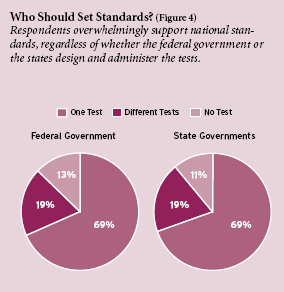 Though support for No Child Left Behind is dwindling, Americans continue to believe that schools should be held accountable through national standards and tests. No less than 69 percent of the public think the federal government should set standards for the country and administer tests in math, science, and reading.
Though support for No Child Left Behind is dwindling, Americans continue to believe that schools should be held accountable through national standards and tests. No less than 69 percent of the public think the federal government should set standards for the country and administer tests in math, science, and reading.
But who should set these standards? Washington politicos continue to debate whether the federal government alone or the states together should write these national standards. Other Americans, perhaps to their credit, seem unable to tell the difference. We discovered this by randomly dividing our respondents into two groups, asking one group whether the federal government should set national standards and tests, while asking the other group whether the states jointly should set those standards and tests. Either way, the same high level of support is observed (see Figure 4): exactly 69 percent favor national standards and testing (Q. 7).
Online Education
One of the latest education innovations to go mainstream is online education, wherein students receive credit for courses taken over the Internet. According to the North American Council for Online Learning, enrollment in online courses in 2000 totaled 45,000. By 2007 enrollments had reached 1 million, about 70 percent of which were for high school courses.
Online education, however, is not immune from political controversy. In December 2007, a Wisconsin state court ruled that virtual charter schools, in which students take Internet-based courses under the supervision of their parents, violated the state’s legal requirement that all public school teachers be properly licensed. Subsequently, the Wisconsin state legislature allowed existing virtual schools to continue operating, but imposed restrictions on their expansion.
Our respondents, meanwhile, seem quite receptive to the idea of online education for their own children. Fully 69 percent of the public, and a solid majority of every subgroup, say that they “would be willing to have a child [of theirs] go through high school taking some academic courses over the Internet” (Q. 8).
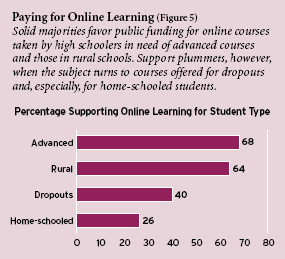
As a matter of public policy, however, the public’s willingness to endorse online education very much depends on the justification given for it (see Figure 5).To explore the issue of public funding, we randomly assigned respondents to one of four questions that identified different targets of online education: rural residents, advanced students, students who dropped out of school, and home-schooled children (Q. 9).
When considering online education for either students in rural communities who have “access to only a limited number of course offerings in their public schools” or advanced students interested in taking courses for college credit, the public expresses considerable support. In these two instances, over 60 percent of respondents support public funding for online education. Across the various subgroups, a majority always express support, and no more than 21 percent of any subgroup ever express opposition.
Support for online education declines precipitously, however, when the subject turns to “children who drop out of high school.” For those students, just 40 percent of respondents support public funding for courses taken over the Internet. Another 30 percent neither support nor oppose public funding for online education for students who drop out of high school, and 31 percent oppose funding.
When told that “some parents prefer to educate their high school children at home” rather than to “send them to a school,” support falls even further. Only 26 percent of the public support public funding for courses taken for credit over the Internet by home-schooled youngsters, another 30 percent neither favor nor oppose public funding, and 44 percent oppose. With the exception of African Americans, a plurality of every subgroup, and sometimes a majority, oppose public funding for online education directed at home-schooled children.
Home Schooling
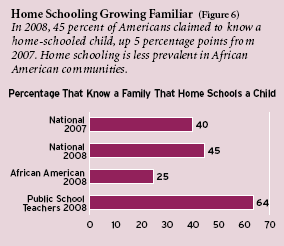 The advent of online education may be among the factors contributing to the extraordinary growth of home schooling in the United States. The most recent data from the National Center for Education Statistics indicate that, as of 2003, 1.1 million American students were being educated at home, up from 850,000 in 1999. Some home-school advocacy organizations place the current totals at more than 2 million.
The advent of online education may be among the factors contributing to the extraordinary growth of home schooling in the United States. The most recent data from the National Center for Education Statistics indicate that, as of 2003, 1.1 million American students were being educated at home, up from 850,000 in 1999. Some home-school advocacy organizations place the current totals at more than 2 million.
The ongoing expansion of home schooling is evident in our survey (see Figure 6). Forty-five percent of our respondents report that they know a family that home schools a child, up from40 percent in 2007.African Americans are least likely to know a home-schooling family, with only 25 percent responding affirmatively. In contrast, 64 percent of public school teachers report knowing a home-schooling family (Q. 10). These numbers are all far higher than the 12 percent of Americans who report knowing students who have taken a course for middle or high school credit over the Internet.
Charter Schools and Vouchers
As they did in 2007, a plurality of the overall public and every subgroup continue to support charter schools. Indeed, supporters of charter schools outnumber opponents more than two to one. The modal response, however, continues to be “neither support nor oppose.” Roughly 40 percent of the American public remain undecided about the merits of these schools, even as enrollment in charter schools has expanded to more than 1.2 million students nationwide (Q. 11).
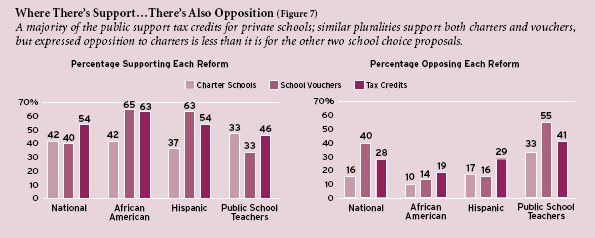
Though Americans have yet to render a verdict on charter schools, they appear evenly divided on vouchers (see Figure 7). For the public as a whole, the number of supporters equals the number of opponents, with only one-fifth of the population refusing to stake out a position one way or the other. As we observed last year, support for vouchers is highest among African Americans and Hispanics. Within these two groups, supporters outnumber opponents by as much as five to one. By contrast, a majority of public school teachers oppose vouchers (Q. 12).
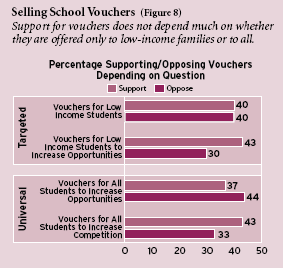
School choice advocates often debate on the relative benefits of directing vouchers toward all children or just to those of low-income families. Some argue that vouchers targeted to low-income families more clearly serve the goal of enhancing equal opportunity and will win broader political support for that reason. Others insist that universal vouchers, available to all families, will have stronger political backing and are the only way to generate the competition between the public and the private sectors that is needed to stimulate broad improvements in school quality.
To gauge the public’s views about such matters, we conducted another experiment. First, we randomly assigned respondents to one of four groups. One group was asked their opinion about the provision of school vouchers to low-income families so their children could attend private schools. Another group was asked the same question but was also told that some people say such a program would create greater equality of opportunity. A third group was asked their opinion about vouchers for any family that desired to send their child to private schools, regardless of the family income. A fourth group was asked the same question but was told that some people say such a program would create more competition for public schools. For the most part, both the public as a whole and the various groups appear equally likely to support proposals that would use government funds to help pay the private school tuitions of either “low income students” or “all students.” African Americans and Hispanics slightly prefer targeted voucher programs, while whites prefer universal programs.
Nor do appeals to competition and equal opportunity hold much sway over the American public (see Figure 8).When told that some people say that a universal program “would introduce much needed competition to the public school system,” overall support for vouchers increases by just a few percentage points. Among African Americans, the percentage who “completely favor” the program actually drops by 22 points. And when told that some people say that a universal program “would improve the educational opportunities available to the poor,” overall support for vouchers does not change at all (Q. 12b-d).
Tax Credits
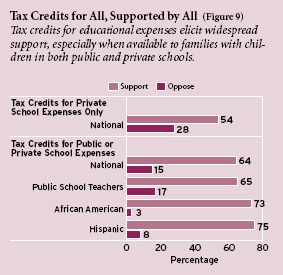 As an alternative to school vouchers, some states ( Arizona, Minnesota, Florida, and Pennsylvania) have established tax credit programs that offset the costs of attending private or public schools. In Pennsylvania, for example, tax credits help cover the costs of school fees, supplies, and computers. To investigate the public’s support for different types of tax credit programs, we randomly asked different groups of respondents separate questions concerning tax credit policy, sometimes referring to programs that only benefit private school students, and sometimes to programs that benefit both private and public school students.
As an alternative to school vouchers, some states ( Arizona, Minnesota, Florida, and Pennsylvania) have established tax credit programs that offset the costs of attending private or public schools. In Pennsylvania, for example, tax credits help cover the costs of school fees, supplies, and computers. To investigate the public’s support for different types of tax credit programs, we randomly asked different groups of respondents separate questions concerning tax credit policy, sometimes referring to programs that only benefit private school students, and sometimes to programs that benefit both private and public school students.
No matter how the question is worded, tax credits elicit higher levels of support than do school vouchers (see Figure 9). A solid majority of the public as a whole, and a plurality of every subgroup, support education tax credits for low- and moderate-income parents who send their children to private schools. African Americans register the highest levels of support, with proponents outnumbering opponents three to one. When tax credits are used to offset expenses for both private and public school students, overall support rises by another 10 percentage points. Two subgroups are especially likely to affirm the most expansive scope of the tax credit program: African Americans and Hispanics, among whom opposition to the program virtually vanishes (Q. 13).
School Integration
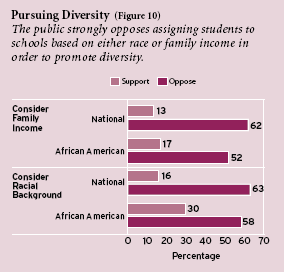 In June 2007, a bitterly divided Supreme Court ruled that public school districts may not foster integration through enrollment programs that take explicit account of students’ race. The justices’ landmark decision in Parents Involved in Community Schools v. Seattle School District No. 1 struck down voluntarily adopted integration programs in Seattle and Jefferson County, Kentucky, and called into question similar race-based systems that operate in hundreds of other districts.
In June 2007, a bitterly divided Supreme Court ruled that public school districts may not foster integration through enrollment programs that take explicit account of students’ race. The justices’ landmark decision in Parents Involved in Community Schools v. Seattle School District No. 1 struck down voluntarily adopted integration programs in Seattle and Jefferson County, Kentucky, and called into question similar race-based systems that operate in hundreds of other districts.
Now that districts may not consider the race of students when assigning them to schools, some policy experts argue that family income might be employed as a substitute criterion. Since minority students tend to come from lower income families, racial integration might be achieved indirectly by giving low-income families their choice of school, whenever that would facilitate integration across socioeconomic lines. The Wake County school district in North Carolina, among others, has won favorable media coverage by introducing such a policy.
To investigate the public’s views about race- and income-based enrollment programs, we asked Americans one of two variations of the following question: “In order to promote diversity, should public school districts be allowed to take the racial background [family income] of students into account when assigning students to schools?”
To the version of the question asking about “racial background,” the public reacts very negatively. Only 16 percent of the public respond that districts “definitely” or “probably” should be allowed to take students’ racial background into account when assigning them to schools. Another 21 percent of the public are unsure, while fully 63 percent of the public say that school districts should not take into account students’ racial background. African Americans are much more likely to support the idea, but still only 30 percent of them think districts should be allowed to take race into account (Q. 14a). Though the Supreme Court was closely divided in the Seattle case, the majority decision has broad public support.
But what if the policy is adjusted to use family income as the basis for assigning students to schools? Does public support then increase? Not at all. In fact, public support for the idea dips slightly (see Figure 10). Just 13 percent of respondents report that they support using family income as a basis for assigning students to a school, while 62 percent say that they are opposed, with the balance uncertain (Q. 14b). Legal experts who wish to circumvent the recent Supreme Court decision by shifting from race to family income clearly have yet to make much headway in the court of public opinion.
Mainstreaming the Disabled
Approximately 15 percent of the country’s elementary and secondary school population have been classified as needing special education, which is partially supported by federal funding under the Individuals with Disabilities Education Act (IDEA).Diagnoses can range from minor learning problems to autism and severe mental retardation to a range of emotional and behavioral disabilities. Whatever the disability, the law mandates that a disabled student be educated in the “least restrictive environment,” a phrase that implies differential treatment depending on the disability, but increasingly has come to mean the “mainstreaming” in standard classrooms of all but those with the most severe disabilities. According to the U.S. Department of Education, the share of disabled students considered to be “fully mainstreamed” has risen from a little more than 30 percent in 1989 to over 55 percent in 2005. Between 1995 and 2005, the share of “emotionally disturbed children” who spend more than 80 percent of their time in a regular classroom jumped from 17 to 35 percent.
Neither teachers nor the public as a whole express much support for the practice of mainstreaming emotionally or behaviorally disabled children. When asked whether students “who have been diagnosed with emotional and behavioral disabilities should be taught in regular classrooms with other students,” only 25 percent of teachers, and 28 percent of the public, favor the idea. The rest say they should be “taught in separate settings instead” (Q. 15).
Single-Sex Public Schools
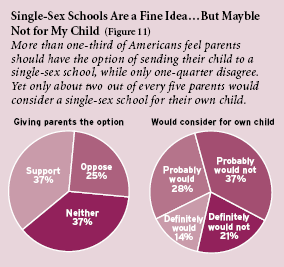
Recent years have witnessed a resurgence of interest in single-sex public schools. Once derided as harmful and anachronistic, the notion of educating boys and girls separately received a major boost in 2006 with the publication of new federal regulations clarifying the legal status of single-sex schools and classrooms. The National Association for Single Sex Public Education projects that, in fall 2008, roughly 400 public schools will offer students at least some opportunity for single-sex education, and a quarter of these schools will enroll only boys or girls.
The American public seems moderately sympathetic to this development (see Figure 11). Thirty-seven percent of respondents support the idea of public school districts offering parents the option of sending their child to a single-sex school, 25 percent oppose the idea, and the remainder are undecided. Support for providing the option of single-sex education is stronger among public school teachers, 47 percent of whom support the idea (Q. 16). Interestingly, women respondents are modestly more likely than men to support single-sex alternatives (39 versus 35 percent).
We also asked parents of school-age children whether they would consider enrolling their own child in a single-sex school. Here responses are more mixed, with more parents reporting that they probably or definitely would not consider doing so than report that they would. Still, 42 percent of all parents, 48 percent of public school teachers, and fully 53 percent of African Americans say that they would consider sending their child to a single-sex school (Q. 17).
The 2008 Presidential Election
Education received scant attention in the 2008 presidential primaries and seems unlikely to emerge as a major issue in the general election. For this, Republican candidates can be grateful. When asked which party “has a better record on education issues” and which party “is more likely to improve the nation’s schools,” Americans give a clear edge to the Democrats. Sixty-one percent of respondents rate the Democrats’ record on education more favorably, and 62 percent think them more likely to improve the public schools. Teachers prefer the Democrats by even larger margins, as do Hispanics and African Americans (Q. 18, 19).
As one might expect, deep partisan divisions underlie this Democratic advantage. On matters involving education, Democrats and Republicans both tend to favor members of their party. They do so, however, with varying levels of conviction. Whereas self-identified Democrats prefer their own party on education by margins of roughly 10 to 1, Republicans do so by margins of just 3 to 1.
Such striking imbalance in the parties’ credibility on education marks a departure from the pattern observed in 2000, when polls compiled by political scientist Patrick McGuinn showed that only 44 percent of Americans thought that the Democrats would do a better job of improving education, compared with 41 percent who favored the GOP in this area. Our 2008 findings reveal a return to the patterns seen in the 1980s and 1990s,when voters consistently favored the Democrats on education by margins of 20 percentage points or more.
Conclusions
With the election season in full swing, this survey offers certain lessons for the two contenders for the U.S. presidency. If Barack Obama and John McCain want to walk in step with the American public, they should acknowledge the flagging performance of schools, for while Americans retain an abiding commitment to public education, the grades that they assign the nation’s schools are increasingly mediocre. Additionally, the candidates should convey support for the principle of accountability, while recognizing the faults of the particular accountability system mandated by No Child Left Behind. Finally, the candidates should remain open to new models of education provision. Though Americans continue to reflect upon the merits of charters, vouchers, online education, and home schooling, an overwhelming majority profess support for at least one of these alternatives to traditional public schools.
William G.Howell is associate professor in the Harris School of Public Policy at the University of Chicago. Martin R.West is assistant professor of education at Brown University and an executive editor of Education Next. Paul E. Peterson is professor of government at Harvard University, senior fellow at the Hoover Institution, and editor-in-chief of Education Next.
|
SURVEY METHODS This survey, sponsored by Education Next and the Program on Education Policy and Governance (PEPG) at Harvard University, was conducted by the polling firm Knowledge Networks (KN) between February 16 and March 15, 2008. KN maintains a nationally representative panel of adults, obtained via list-assisted random digit–dialing sampling techniques, who agree to participate in a limited number of online surveys. Because KN offers members of its panel free Internet access and a WebTV device that connects to a telephone and television, the sample is not limited to current computer owners or users with Internet access. When recruiting for the panel, KN sends out an advance mailing and follows up with at least 15 dial attempts. The panel, then, is updated quarterly. Detailed information about the maintenance of the KN panel, the protocols used to administer surveys, and the comparability of online and telephone surveys is available online (www.knowledgenetworks.com/quality/). The main findings from the Education Next –PEPG survey reported in this essay are based on a nationally representative stratified sample of 2,500 adults (age 18 years and older) and an oversample of 700 public school teachers. The sample consists of 2,546 non-Hispanic whites, 250 non-Hispanic blacks, and 239 Hispanics. We use poststratification population weights to adjust for survey nonresponse as well as for the oversampling of teachers. These weights ensure that the observed demographic characteristics of the final sample match the known characteristics of the national adult population. In general, survey responses based on larger numbers of observations are more precise, that is, less prone to sampling variance, than those made across groups with fewer numbers of observations. As a consequence, answers attributed to the national population are more precisely estimated than are those attributed to subgroups. With 3,200 total respondents, the margin of error for responses given by the full sample in the Education Nex t–PEPG survey is roughly 1 percentage point. On many items, we conducted experiments to examine the effect of variations in the way questions are posed. The figures and tables present separately the results for the different experimental conditions. Percentages do not always add precisely to 100 as a result of rounding to the nearest percentage point. |
This article appeared in the Fall 2008 issue of Education Next. Suggested citation format:
Howell, W.G., West, M.R., and Peterson, P.E. (2008). The 2008 Education Next—PEPG Survey of Public Opinion: Americans think less of their schools than of their police departments and post offices. Education Next, 8(4), 12-26


